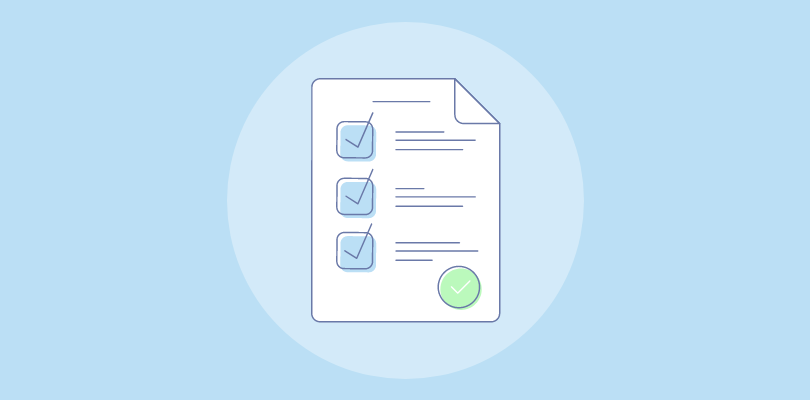In this era of talent wars, understanding the nuances of employee assessments is pivotal.
While pre-employment assessments can be a compass, guiding companies to undiscovered talent, post-employment assessments, on the other hand, are the north star for ongoing development, steering growth and success.
So, let’s decode both of them.
Here is a detailed guide where I unravel the layers of these powerful tools, throwing light on assessments for employment, their uses, benefits, and their impact on the journey from a potential candidate to a star employee.
Let’s get started.
What Is an Employee Assessment?
Employee assessment is a tool used by organizations to evaluate the abilities, skills, and potential of individuals. In the context of pre-employment, these assessments help determine whether a candidate is suitable for a particular job role. They often include aptitude tests, personality questionnaires, and skill evaluations.
For example, a software company might use coding tests and problem-solving exercises to assess the technical competencies of software engineer candidates.
Post-employment assessments evaluate an employee’s performance, growth, and development within the organization. These assessments can be performance reviews, 360-degree feedback, or career development planning.
For instance, a sales manager might be assessed based on sales competency, targets achieved, customer feedback, and their ability to lead and motivate their team.
Both types of assessments are crucial for organizational growth and ensure the right fit between employees and their roles.
| Find out how Woworks saw a 40% reduction in employee training time and improved the learning experience using ProProfs Quiz Maker. |
What Is the Purpose of Employee Assessment?
Employee assessments serve several key purposes. First, they clarify job expectations. By outlining clear benchmarks and standards, employees understand what is expected of them, which helps align their efforts with the company’s goals and ensures everyone is working towards the same objectives.
Secondly, assessments inform critical employment decisions. They provide the data needed to make fair decisions about hiring, promotions, pay raises, and training needs. This ensures that these decisions are based on objective criteria rather than subjective opinions, fostering a culture of fairness and transparency.
Lastly, assessments facilitate continuous feedback and development. Regular evaluations help employees recognize their strengths and areas for improvement. This ongoing feedback not only aids in personal and professional growth but also demonstrates the organization’s commitment to its development, which can boost morale and retention.
What Are the Benefits of Employee Assessments?
Employee assessments, both pre-employment and post-employment, offer a range of benefits for both employers and employees.
Here’s a breakdown of these benefits:
Pre-Employment Assessments
- Improved Hiring Accuracy
Pre-employment assessments are essential tools in accurately determining the suitability of candidates for specific roles. By evaluating skills, knowledge, personality traits, and cognitive abilities, these assessments help employers match candidates with job requirements more precisely.
This accuracy is crucial, as the U.S. Department of Labor’s finding that a bad hire can cost up to 30% of the individual’s first-year earnings highlights the financial risk of inaccurate hiring.
- Efficient Screening Process
These talent assessments expedite the hiring process by quickly identifying the most promising candidates from a large pool of applicants. This is especially beneficial in high-volume recruitment scenarios, where manually reviewing each application is impractical. Organizations can allocate their human resources more effectively by automating part of the screening process.
- Reduced Bias
Structured assessments help mitigate unconscious biases inherent in the hiring process. By focusing on objective, job-relevant criteria, these tools support fairer hiring practices. This approach not only enhances diversity in the workplace but also strengthens the employer’s reputation for fairness and inclusivity.
- Legal Compliance
Properly designed assessments can aid in complying with various employment laws and regulations. This is particularly significant in avoiding discrimination lawsuits. Assessments must be relevant to the job and consistently applied to all candidates to ensure legal compliance and fairness.
- Predicting Job Performance
Cognitive tests and personality assessments are valuable predictors of future job performance, as per SHRM. These tools can forecast how well a candidate will perform in a role, potentially leading to higher productivity and job satisfaction.
Post-Employment Assessments
- Employee Development
Regular assessments after hiring can pinpoint specific areas for employee improvement. This leads to more focused and effective training programs and development, ultimately enhancing skills and productivity. Employee development is a continual process that not only benefits the individual but also contributes to the organization’s overall skill set.
- Career Pathing and Succession Planning:
These assessments for employee performance inform career pathing and succession planning by evaluating employees’ strengths, weaknesses, and potential. This helps identify internal candidates for future leadership roles, ensures a smoother transition, and reduces the need for external recruitment.
- Performance Evaluation
Post-employment assessments provide a structured framework for evaluating employee performance. This structured approach enables managers to offer constructive feedback and set clear goals for improvement, leading to a more objective and equitable performance appraisal process.
- Enhancing Employee Engagement
Implementing regular assessments shows employees that the organization is committed to their personal and professional growth. This engagement is crucial for job satisfaction and can lead to increased productivity and loyalty. Engaged employees are more likely to contribute positively to the workplace culture.
- Organizational Alignment
These assessments ensure that employees’ skills, goals, and progress are in sync with the organization’s strategic objectives. Alignment with the organization’s goals is key to achieving overall success and maintaining a competitive edge in the market.
- Retention
Post-employment assessments are focused on career development and satisfaction and contribute to higher retention rates. As per Gallup’s research, businesses with high engagement levels see significantly lower turnover, underscoring the importance of keeping employees engaged and satisfied.
Watch: How to Choose the Best Assessment Software
Types of Employee Assessments
Employee assessments are a great way for organizations to understand their workforce better and make informed decisions. Let’s dive into the main types of assessments, with some examples to show how they’re used in the real world.
1. Skills Assessments
Skills assessments are designed to measure specific job-related abilities. Think of them as practical tests that ensure candidates can actually do what their resumes claim. For instance, a coding test for software developers evaluates their programming skills.
These assessments are also useful for current employees. For example, a graphic designer might be given a design task to assess their proficiency with design software. This helps managers identify skill gaps and provide targeted training to improve those areas.
By ensuring that employees have the necessary skills, organizations can maintain high performance standards and stay competitive.
2. Cognitive Ability Tests
Cognitive ability tests evaluate how well a person can solve problems, think critically, and learn new information. Imagine you’re hiring a project manager who needs to juggle multiple tasks and think on their feet. A cognitive ability test might include puzzles and logic questions to see how quickly and effectively they can process information.
These tests are especially useful for roles requiring quick thinking and adaptability. For example, in the finance sector, cognitive tests can help assess a candidate’s ability to analyze data and make informed decisions under pressure, ensuring they can handle the fast-paced nature of the job.
3. Personality Assessments
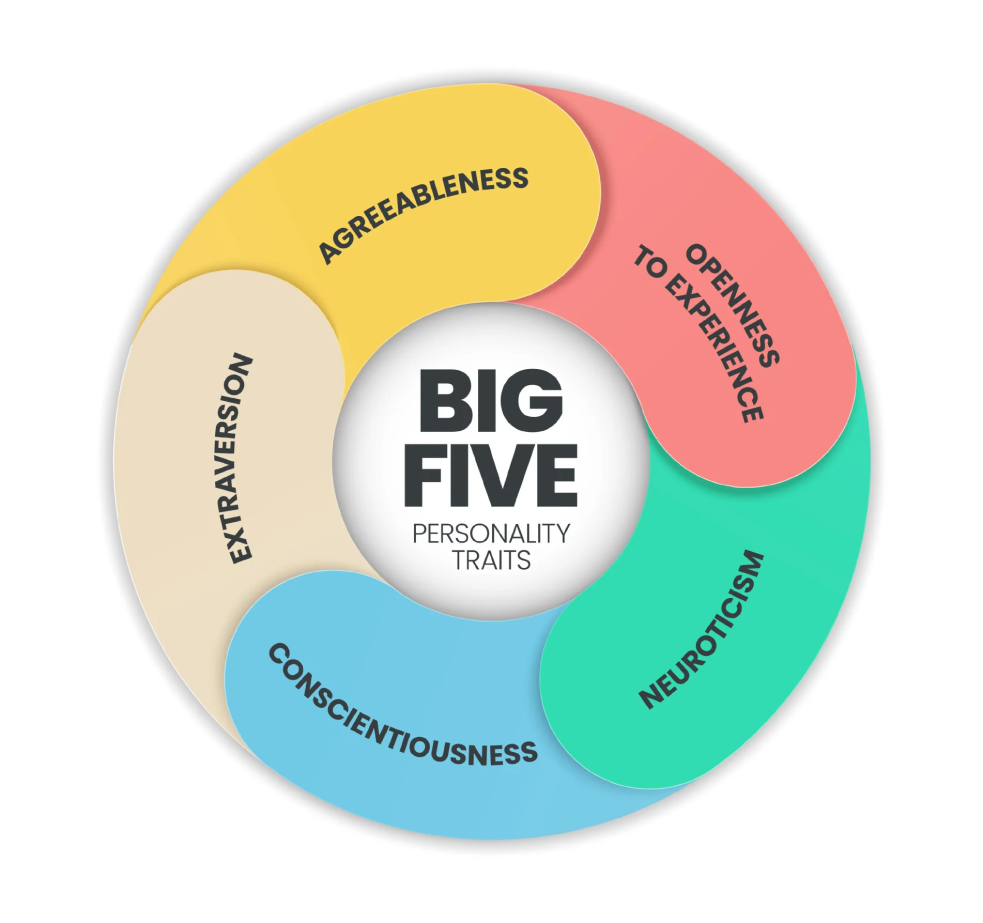
(Image Source: Simple Psychology)
Personality assessments delve into an individual’s traits, preferences, and work style. Tools like the Myers-Briggs Type Indicator (MBTI) or the Big Five Personality Traits model can reveal a lot about a person’s character.
For instance, if you’re building a team for a collaborative project, you’d want to know who the extroverts and introverts are so you can assign roles that fit their natural tendencies. This can lead to better teamwork and higher productivity.
Personality assessments are also valuable for leadership roles. For example, understanding a manager’s leadership style through personality testing can help tailor development programs to enhance their strengths and address their weaknesses.
Read: What Is a Leadership Assessment Test
4. Emotional Intelligence Tests
Emotional intelligence (EI) tests measure how well a person can understand and manage their own emotions, as well as those of others. This is crucial for roles that involve a lot of interaction, like customer service or management.
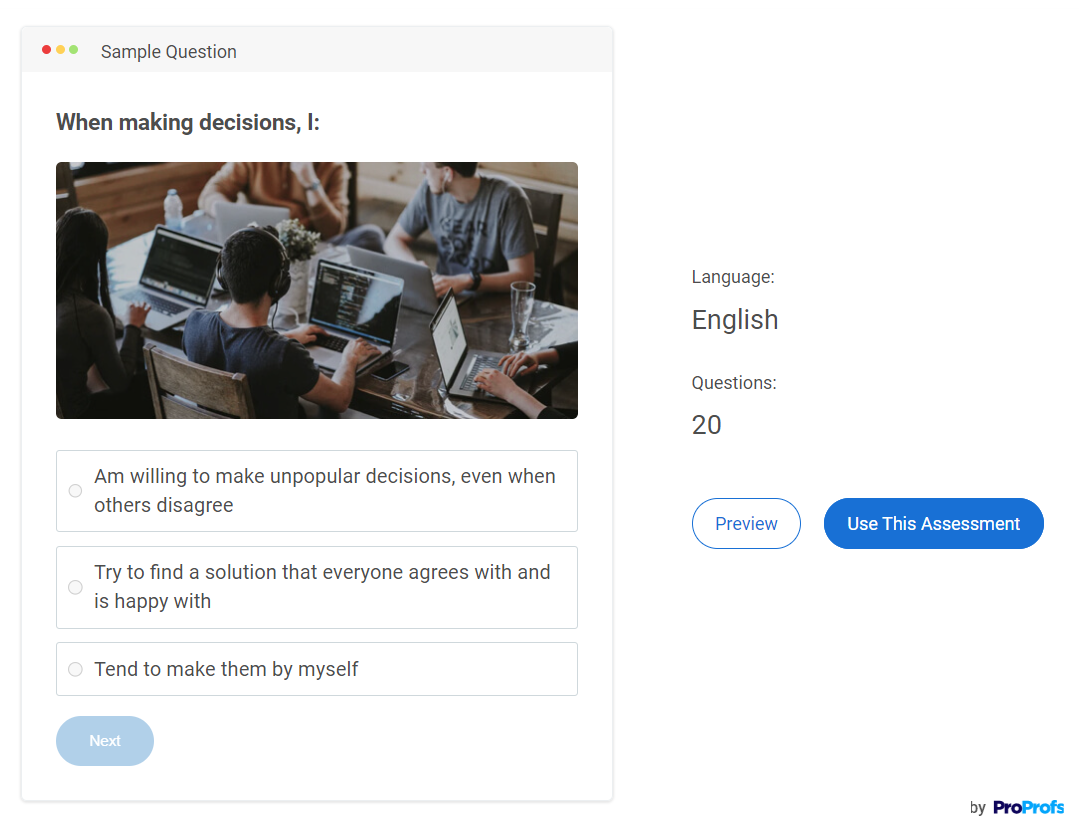
For example, an EI test might present a scenario where a customer is upset, and the candidate has to demonstrate how they would handle the situation calmly and empathetically.
High EI is linked to better teamwork and leadership. In a healthcare setting, where empathy and stress management are essential, EI tests help ensure that staff can provide compassionate care even in challenging situations.
5. 360-Degree Feedback
360-degree feedback collects input from an employee’s supervisors, peers, subordinates, and sometimes clients. It’s like getting a full-circle view of someone’s performance.
For example, a manager might receive feedback from their boss and their team and colleagues, providing a comprehensive picture of their strengths and areas for improvement.
This feedback method helps build self-awareness and promotes personal growth. It’s particularly useful in leadership development, where understanding how one is perceived by others can lead to significant improvements in management skills and team dynamics.
6. Situational Judgment Tests (SJTs)
SJTs present hypothetical, job-related scenarios to assess judgment, problem-solving, and decision-making skills.
Imagine you’re hiring for a customer service role. An SJT might include a scenario where a customer is unhappy with a product, and the candidate has to choose the best way to handle the situation.
These tests predict how well candidates will perform in real-world situations. They are also useful for roles in fast-paced environments like retail, where quick thinking and effective decision-making are critical for maintaining customer satisfaction and operational efficiency.
7. Job Knowledge Tests
Job knowledge tests assess a candidate’s or employee’s technical or theoretical expertise in a specific field. These tests are tailored to the particular knowledge required for the job.
For example, in the retail industry, a job knowledge test for a store manager might include questions on inventory management, sales strategies, and customer service protocols. This ensures that the manager has the necessary knowledge to run the store effectively and respond to various operational challenges.
Other Types of Employee Assessments
- Integrity Tests: Evaluate honesty and ethical behavior, helping to ensure a trustworthy workforce.
- Physical Ability Tests: Measure physical capabilities relevant to job requirements and important for manual labor roles.
- Engagement and Satisfaction Surveys: Gauge employee investment in their work and overall job satisfaction.
- Performance Reviews: Regular evaluations of an employee’s work performance against set objectives.
- Career Development Assessments: Identify strengths, weaknesses, and career aspirations to guide development plans.
- Employee Satisfaction Surveys: Measure how content employees are with their job and work environment.
- Succession Planning Assessments: Evaluate potential for leadership roles to plan for future organizational needs.
- Cultural Fit Assessments: Determine how well an employee’s values and behaviors align with company culture.
- Training Needs Analysis: Assess the training and development needs to enhance job performance.
- Benchmarking Assessments: Compare performance and competencies with industry standards to identify improvement areas.
Using these assessments, organizations can build a well-rounded and effective workforce, tailored to their specific needs and goals.
FREE. All Features. FOREVER!
Try our Forever FREE account with all premium features!
Uses of Employee Assessments
A study found that 63% of HR professionals reported using some kind of assessment, and 53% confirmed using them in both pre and post-hire stages, highlighting their widespread adoption in talent management strategies.
Here are some of the major uses of employee assessments:
- Objective Candidate Evaluation
These assessments provide a structured and objective way to evaluate candidates’ capabilities, personality traits, and overall suitability for specific roles. They include a variety of methodologies, such as skills tests, cognitive ability evaluations, personality questionnaires, and situational judgment tests.
- Enhanced Hiring Accuracy
By going beyond resumes and interviews, pre-employment assessments can predict future job performance and cultural fit, leading to better hiring outcomes. For instance, they are more effective than traditional hiring methods, which are as predictive as a coin flip.
- Reduced Turnover
By ensuring a good job fit, these assessments can reduce turnover. Companies that implement structured interview processes, including pre-employment assessments, generally see lower turnover rates.
- Continuous Performance Management
Post-employment assessments are crucial for ongoing performance management, helping to identify areas where employees excel and where they need improvement. This enables targeted training and development opportunities.
- Employee Engagement and Retention
Regular assessments can make employees feel valued and appreciated, which is linked to higher engagement and retention. In fact, companies that provide consistent feedback have turnover rates 14.9% lower than those that don’t.
- Informed Decision-Making
These assessments provide data for making informed decisions about promotions and compensation, helping to identify the most qualified candidates for advancement.
Let’s check out some real-life examples:
- Google uses structured interviews and assessments in its hiring process to ensure it selects candidates who are not only skilled but also a good fit for the company culture.
- Deloitte has implemented a comprehensive performance management system focusing on frequent, informal check-ins between employees and managers rather than annual reviews.
- IBM uses AI-powered skill assessments to identify skill gaps in their workforce, helping in targeted training and career development.
| Learn how Acer trains its employees using ProProfs Quiz Maker: Read the Full Story |
How to Build an Employee Assessment System
When building a comprehensive employee assessment system that includes pre- and post-employment evaluations, it’s important to consider the entire employee lifecycle.
Here’s a step-by-step process:
Step 1: Define Objectives
Start by clarifying the purpose of your assessment system. For pre-employment, the focus might be on identifying candidates with the right skills and cultural fit.
On the other hand, post-employment assessments could aim at performance evaluation, career development, or identifying training needs.
For instance, a financial firm might use pre-employment assessments to gauge analytical skills, while post-employment assessments could focus on ongoing professional development and compliance training.
Step 2: Determine Assessment Criteria
Next, establish what you’ll be assessing at each stage. Pre-employment assessments could include cognitive ability tests, personality assessments, and technical skills tests, while post-employment assessments might involve evaluating job performance, adherence to company values, and professional growth.
For example, a marketing role might require creativity tests pre-employment, as well as performance metrics like campaign ROI post-employment.
Step 3: Choose Assessment Methods
Select appropriate methods for each type of assessment. Pre-employment assessments might involve structured interviews, skill-based tests, or personality questionnaires, whereas post-employment could include 360-degree feedback, performance reviews, and self-assessment tools.
In a customer service context, you might use role-playing scenarios in pre-employment screening and customer feedback as a metric in post-employment evaluations.
Step 4: Create a Standardized Evaluation Process
It’s crucial to ensure consistency across both pre-employment and post-employment evaluations to maintain fairness and validity. This could involve using standardized rating scales or structured interview templates.
For instance, applying the same competency framework for evaluating both potential hires and current employees can ensure alignment with organizational goals.
Step 5: Develop Tools and Resources
Invest in technology and resources that support your assessment system. This could range from applicant tracking systems for pre-employment screening to performance management software for tracking employee progress.
Automation can streamline the pre-employment screening process, while data analytics can provide insights into post-employment performance trends.
Step 6: Train Evaluators
Ensure that those conducting assessments are trained and calibrated. For pre-employment, this might involve training interviewers to avoid bias, while for post-employment, it could mean training managers on how to give constructive feedback.
Regular training sessions can help maintain the integrity and effectiveness of your assessment system.
Step 7: Pilot the System
Test your system in phases, starting with a small group before a full rollout. This allows you to gather feedback and make adjustments.
For example, piloting a new online assessment tool for job applicants in one department before implementing it company-wide.
Step 8: Collect and Analyze Data
Regularly gather and analyze data from employment assessment tests to gauge their effectiveness.
This can involve surveying new hires about the recruitment process or analyzing performance review data to identify trends and training needs.
Step 9: Make Adjustments
Use the insights gained to refine your assessment processes. This might involve updating the criteria used in pre-employment assessments or modifying the framework for performance evaluations based on employee feedback and business needs.
Step 10: Implement and Monitor
Fully implement your assessment system and continue to monitor its effectiveness. Regular review and adaptation will help ensure that it remains relevant and aligned with your organizational goals.
This could involve annual reviews of hiring processes and performance management systems to ensure they meet the organization’s evolving needs.
So, a well-rounded employee assessment system covering pre- and post-employment stages is key to maintaining a high-performing and well-aligned workforce.
It requires careful planning, consistent application, and ongoing refinement to ensure it supports the organization’s objectives effectively.
Watch: How to Create an Assessment Online
Now that you know all about employee assessments, let’s look at the top options on the market to conduct such assessments.
What Are the Top Employee Assessment Tools?
Here are my picks for the top three employee assessment tools based on my own experience, in-depth research, and feedback from colleagues. I also considered unbiased reviews and customer testimonials from independent sources.
1. ProProfs Quiz Maker – Best for Easily Creating Secure Quizzes & Assessments With AI or Templates
I find ProProfs Quiz Maker to be an incredibly versatile and user-friendly tool for creating employee assessment tests. It simplifies the process of creating quizzes on various topics, offering a vast selection of over 200 customizable assessment tests.
One of the features I appreciate most is the flexibility in quiz creation. Whether I’m using the AI-driven generator or exploring the extensive library of more than 100,000 templates and a million ready-made questions, the platform makes it easy to design effective assessments.
The inclusion of more than 20 question types, especially the video response option, is particularly useful for evaluating performance and identifying training needs.
Additionally, ProProfs Quiz Maker comes with robust security and customization options. It allows me to shuffle questions and answers, implement proctoring, disable tab switching, and create question banks, all while maintaining a professional appearance aligned with my brand through customizable logos, colors, and fonts.
What You’ll Like
- Intuitive and user-friendly tool, accessible to all skill levels.
- Rapid assessment creation with advanced AI quiz technology and an extensive resource library.
- Access to hundreds of expertly crafted assessments on various business topics, including sales, support, leadership, operations, workplace communication, and more.
- Comprehensive AI-generated reports and statistics for precise evaluation of knowledge and skills.
- Multilingual support for English, Spanish, and over 70 other languages, catering to a diverse audience.
- Clear and adaptable pricing plans, offering great value for your investment.
What You May Not Like
- A dark mode option could enhance the user experience.
- There’s no downloadable version available for offline use.
Pricing
Forever FREE for short quizzes and all essential features. Paid starts at $19.99/month.
2. Trakstar – Best for Performance Reviews
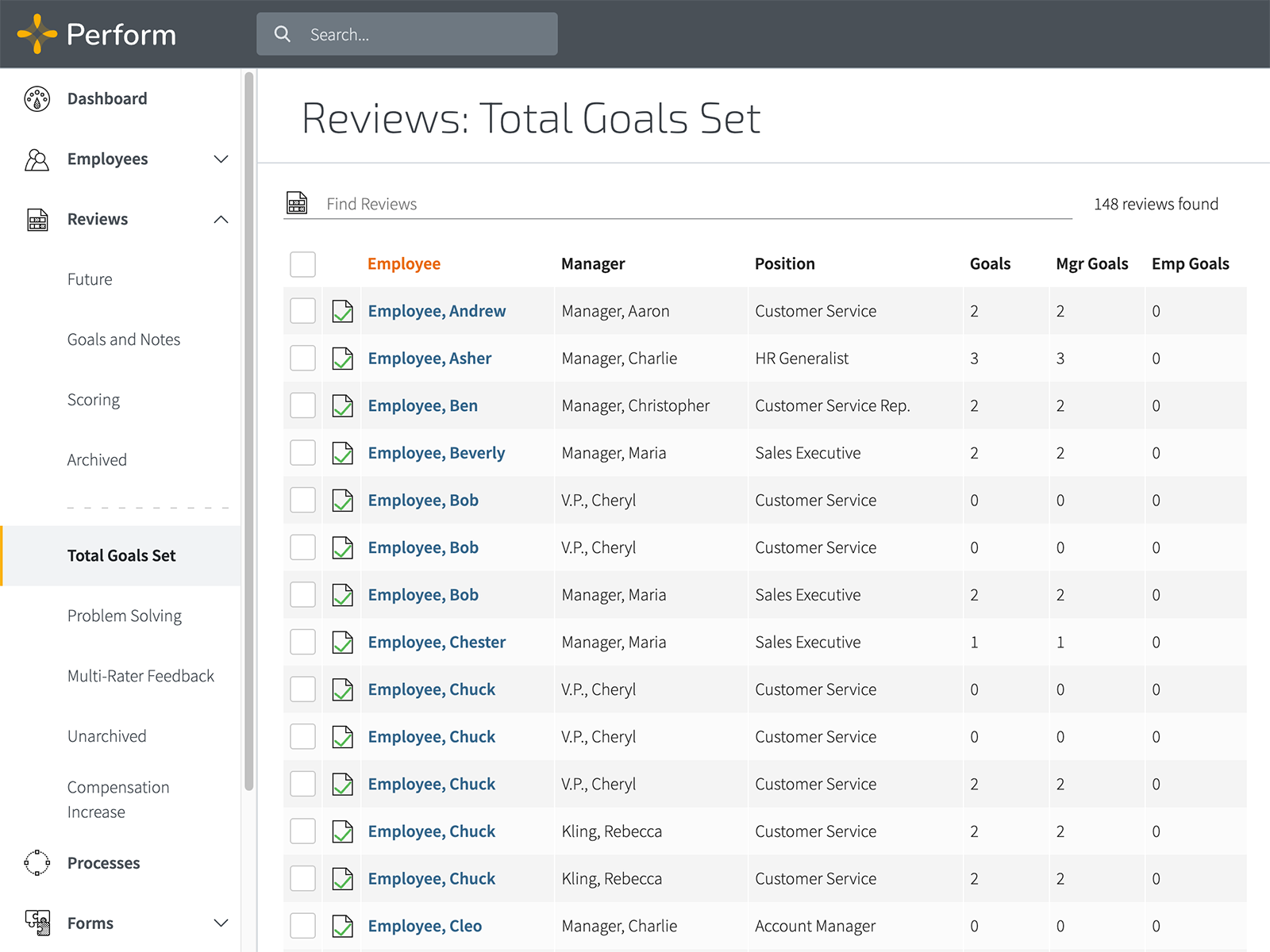
Image Source: Software Suggest
Trakstar is a powerful performance management tool that drives employee performance through continuous feedback and goal-setting. I appreciate its customizable evaluation forms, templates, data analytics, and automated workflows, which make implementing a performance management program straightforward.
The progress-tracking feature is handy. Timelines visually represent employee progress over time, simplifying the monitoring process. I also like how Trakstar streamlines reviews and feedback with customizable options, including multiple surveys and 360-degree feedback, which help build a supportive work environment.
Trakstar’s employee self-assessment feature stands out, allowing employees to evaluate their performance and prepare for annual reviews. For managers, the available reports and dashboards make it easy to monitor team performance and track both department and individual goals.
What You’ll Like
- Customizable templates and rating scales for various review types.
- Easy survey distribution and broad feedback collection.
- Goal-setting and performance tracking through 360-degree reviews.
- Automated review reminders and streamlined processes.
- Integration with other HR software and platforms.
What You May Not Like
- Trakstar doesn’t support corrective actions or performance improvement plans.
- The employee scoring system can feel overly complex.
Pricing
Custom quote available on request
3. eSkill – Best for Large Enterprises
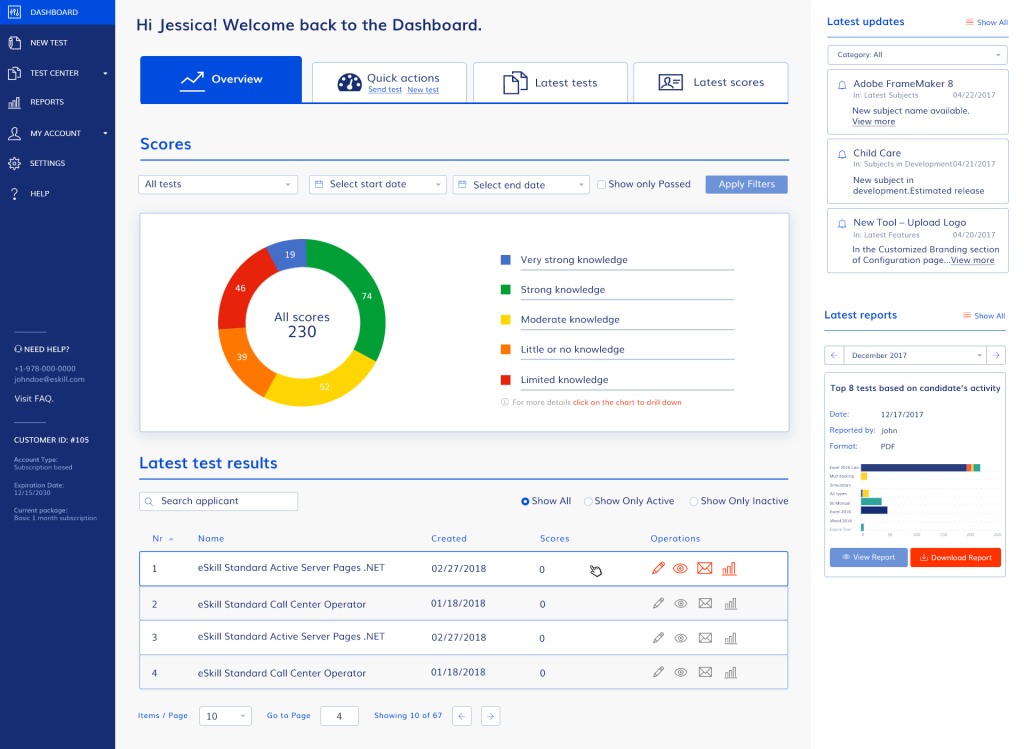
Image Source: eSkill
eSkill is a robust employee assessment tool tailored for large organizations. Its extensive range of online tests and simulations helps organizations accurately measure employees’ skills and abilities across various domains and roles.
I appreciate how eSkill allows organizations to identify strengths and areas for improvement, enabling the development of targeted training programs to boost performance and productivity.
One of my favorite features is eSkill’s ability to assess training program outcomes with comprehensive reports. This data-driven approach aids in making informed decisions for future improvements. eSkill also offers customized solutions, ensuring that each organization’s unique goals and objectives are met, making it a flexible and reliable tool for workforce enhancement.
What You’ll Like
- A wide range of online tests and simulations that assess employee skills across various roles.
- Customized solutions tailored to the specific needs and goals of each organization.
- User-friendly portal for creating and adjusting aptitude tests with ease.
- Simulation and video response questions that replicate real-life job situations for a thorough assessment of abilities.
What You May Not Like
- eSkill’s user interface feels a bit dated and could benefit from updates.
- Some pre-built test questions may be irrelevant or outdated.
Pricing
Custom quote
Unlock Success With Effective Employee Assessments
So, pre- and post-employment assessments ensure the right fit between a job and its occupant, offering invaluable insights into candidates’ abilities and growth potential. They are key in reducing the risk of costly hiring mistakes and shaping a skilled workforce.
To streamline this crucial process, you can use a robust assessment tool such as ProProfs Quiz Maker. Its AI quiz maker simplifies creating tailored assessments, complemented by features like customizable templates, instant grading, detailed reporting, and powerful security and anti-cheating features, thereby enhancing the effectiveness and efficiency of employee evaluations.
FREE. All Features. FOREVER!
Try our Forever FREE account with all premium features!
Frequently Asked Questions About Employee Assessments
Creating an employee assessment involves defining clear objectives, such as evaluating skills, productivity, or attitude. You need to tailor the assessment to job-specific competencies and company goals. Include qualitative and quantitative measures, such as performance metrics, peer feedback, and self-assessment. Nowadays, you can use a good online tool such as ProProfs Quiz Maker to create assessments in just a few seconds.
An employee assessment example could be a performance review where a manager evaluates an employee’s achievements against their job responsibilities and goals. It often includes metrics like sales targets achieved, customer feedback, project completion rates, and adherence to deadlines. Behavioral aspects like teamwork, leadership, and adaptability may also be reviewed. This assessment can be complemented by self-evaluation forms and peer reviews, providing a comprehensive view of the employee’s performance.
 Tips
Tips
We’d love to hear your tips & suggestions on this article!
FREE. All Features. FOREVER!
Try our Forever FREE account with all premium features!

 We'd love your feedback!
We'd love your feedback! Thanks for your feedback!
Thanks for your feedback!


